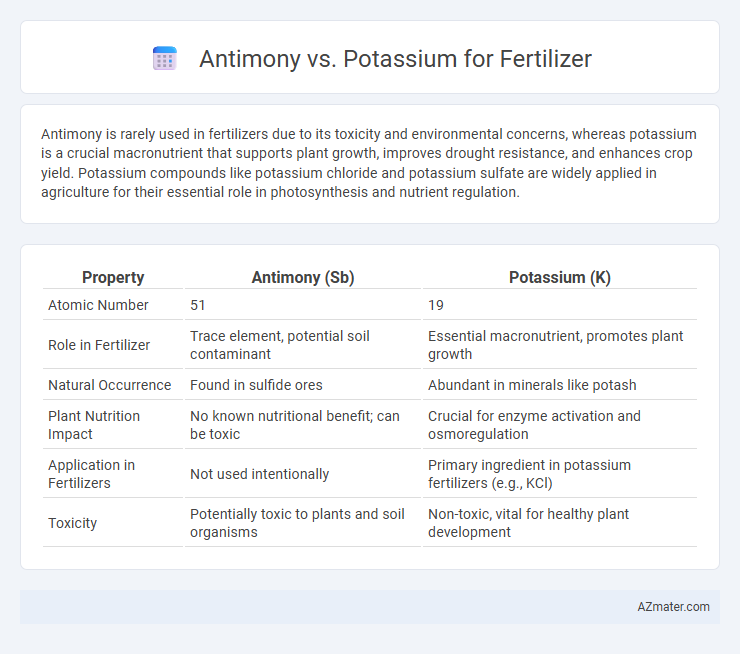Antimony is rarely used in fertilizers due to its toxicity and environmental concerns, whereas potassium is a crucial macronutrient that supports plant growth, improves drought resistance, and enhances crop yield. Potassium compounds like potassium chloride and potassium sulfate are widely applied in agriculture for their essential role in photosynthesis and nutrient regulation.
Table of Comparison
| Property | Antimony (Sb) | Potassium (K) |
|---|---|---|
| Atomic Number | 51 | 19 |
| Role in Fertilizer | Trace element, potential soil contaminant | Essential macronutrient, promotes plant growth |
| Natural Occurrence | Found in sulfide ores | Abundant in minerals like potash |
| Plant Nutrition Impact | No known nutritional benefit; can be toxic | Crucial for enzyme activation and osmoregulation |
| Application in Fertilizers | Not used intentionally | Primary ingredient in potassium fertilizers (e.g., KCl) |
| Toxicity | Potentially toxic to plants and soil organisms | Non-toxic, vital for healthy plant development |
Introduction to Antimony and Potassium in Agriculture
Antimony and potassium play distinct roles in agriculture, with potassium being a vital macronutrient essential for plant growth, enzyme activation, and water regulation. Antimony, a trace element, is less understood but studied for its potential toxic effects and minimal nutritional benefits in soils and crops. Potassium fertilizers are widely applied to improve crop yields, while antimony presence is typically monitored to avoid contamination and soil toxicity.
Chemical Properties Relevant to Plant Growth
Antimony in fertilizers exists mostly as a trace element with limited direct benefits for plant growth, often acting as a potential contaminant due to its toxicity at higher concentrations. Potassium, an essential macronutrient, plays a crucial role in enzyme activation, osmoregulation, and maintaining cellular turgor pressure, directly influencing photosynthesis and nutrient transport. The chemical properties of potassium, including its high solubility and cation exchange capacity, make it readily available for uptake by plant roots, unlike antimony, which is poorly bioavailable and less important in nutrient cycles.
Role of Potassium as an Essential Plant Nutrient
Potassium is a vital macronutrient in fertilizers, crucial for plant growth, enzyme activation, water regulation, and photosynthesis, directly influencing crop yield and quality. Unlike antimony, which has no beneficial role in plant nutrition and can be toxic, potassium supports nutrient transport, improves drought resistance, and enhances disease tolerance in plants. Its presence in the soil ensures optimal cellular function, making potassium indispensable for sustainable agriculture and effective fertilization strategies.
Antimony: Industrial Use Versus Agricultural Application
Antimony is primarily utilized in industrial applications such as flame retardants, lead-acid batteries, and alloys, with limited direct use in fertilizers due to its potential toxicity to plants and soil microorganisms. In contrast, potassium is a crucial macronutrient widely applied in agriculture to enhance plant growth, improve drought resistance, and increase crop yields through potassium-based fertilizers like potassium chloride and potassium sulfate. The agricultural application of antimony remains minimal compared to potassium, as its accumulation in soil can lead to environmental and health concerns, necessitating careful management and monitoring.
Effect on Soil Health: Potassium vs Antimony
Potassium is an essential macronutrient that improves soil fertility by enhancing water retention, nutrient uptake, and microbial activity, promoting overall soil health and crop growth. In contrast, antimony is not a nutrient and can accumulate in the soil as a toxic element, negatively affecting soil microbial communities and reducing soil quality over time. Excess antimony contamination can lead to impaired nutrient cycling and decreased soil productivity, whereas potassium contributes positively to long-term soil sustainability.
Impact on Crop Yield and Quality
Antimony in fertilizers can be toxic to plants, reducing crop yield and quality by interfering with nutrient uptake and causing oxidative stress. Potassium, an essential macronutrient, enhances crop yield and improves quality by promoting photosynthesis, water regulation, and enzyme activation. Optimizing potassium levels in soil is critical for maximizing crop production, while minimizing antimony contamination is necessary to avoid detrimental effects on plant health.
Environmental and Health Considerations
Potassium is a vital macronutrient in fertilizers that supports plant growth without posing significant environmental or health risks, whereas antimony, often present as a contaminant in some fertilizers, can accumulate in soil and water, leading to toxicity for plants, animals, and humans. Antimony exposure is linked to respiratory issues, skin irritation, and long-term carcinogenic effects, making its presence in agricultural inputs a serious concern. Sustainable fertilizer use prioritizes potassium supplementation while minimizing antimony contamination to protect ecosystems and public health.
Regulatory Guidelines for Fertilizer Use
Regulatory guidelines for fertilizer use emphasize strict limits on antimony concentrations due to its toxicity and potential to accumulate in soil and crops, posing environmental and health risks. Potassium is widely regulated for its nutrient content rather than toxicity, with standards focusing on maintaining soil nutrient balance and preventing over-application that can lead to water contamination. Compliance with regional fertilizer regulations, such as those from the EPA or EFSA, mandates precise labeling of antimony residues and potassium levels to ensure safe agricultural practices and protect ecosystem health.
Costs, Availability, and Practicality for Farmers
Antimony is rarely used in fertilizers due to high costs and limited availability, making it impractical for most farmers. Potassium, an essential nutrient for plant growth, is widely available and cost-effective, commonly found in potash fertilizers that support crop yield and soil health. Farmers benefit from potassium's proven effectiveness and accessibility, while antimony remains unsuitable for large-scale agricultural use.
Conclusion: Choosing Safe and Effective Fertilizers
Antimony content in fertilizers poses toxicity risks to plants and soil microorganisms, making its presence undesirable, while potassium is an essential macronutrient that promotes plant growth and improves crop yields. Choosing fertilizers with high potassium levels and minimal or no antimony contamination ensures safer agricultural practices and healthier soil ecosystems. Therefore, prioritizing potassium-based fertilizers with verified safety standards is critical for effective and sustainable farming.

Infographic: Antimony vs Potassium for Fertilizer
 azmater.com
azmater.com